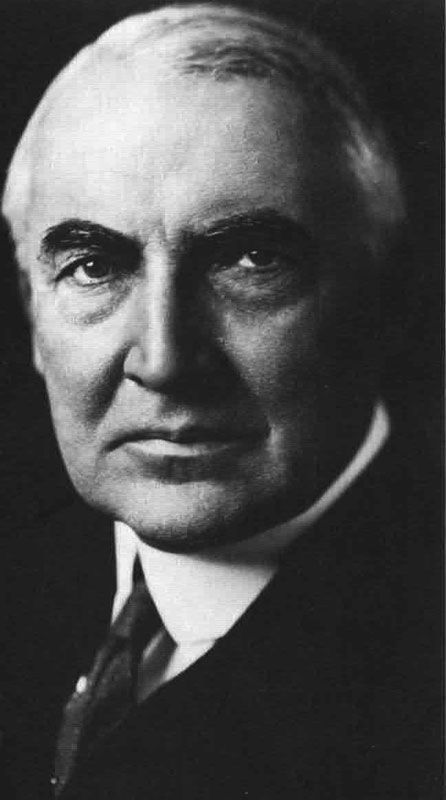The Year 1922
by Diana Loski
Warren G. Harding
(Library of Congress)
One hundred years ago, New Year’s Day 1922 came to us on a Sunday – and during that same month there was a gigantic snowstorm, the largest ever recorded in Washington, D.C. The snow was so immense and heavy that the roof of a popular theater in the city collapsed, killing 98 people.
Gettysburg, Pennsylvania saw its share of the intense snowstorm as well, but the people were used to inclement storms and fared much better than their neighboring cities to the south.
In 1922, Warren G. Harding, a former newspaper publisher from Ohio, was completing his first year as President of the United States; he had been inaugurated on March 2, 1921. Shortly after his first anniversary in the White House, President Harding had a radio installed there. He made the first radio speech uttered by a President to the American people. Although the Americans did not know it at the time, the illegal and surreptitious leasing of oil reserves in Wyoming was occurring to pad the pockets of many in the Harding administration. It was the making of the yet future Teapot Dome Scandal.
In the nation’s capital there were other milestones. The first woman senator, Rebecca Felton, was appointed to fill a vacancy left due to the death of a sitting senator from the state of Georgia. On May 30, 1922 the long-anticipated Lincoln Memorial was dedicated near the banks of the Potomac River.
Across the world, there was much unrest and other noteworthy occurrences. In Italy, Benito Mussolini became the youngest Prime Minister of that country. Germany was crippled economically due to the demands of the Treaty of Versailles, which had placed the entire fault of the recent world war on that nation. In India, Mahatma Gandhi was arrested for inciting a large-scale protest against British control in India. In the Middle East, the Ottoman Empire officially came to a close after six hundred years of rule. In Ireland, a civil war raged. In Egypt, archaeologist Howard Carter and English aristocrat Lord Carnarvon discovered the ancient tomb of King Tutankhamen. In Moscow, Joseph Stalin was selected as general secretary to the Communist party. England’s King George V finished a large concrete tennis complex in Wimbledon.
The influenza epidemic, which raged across the globe in 1918 and 1919 was no longer considered an epidemic, but even in 1922 the waning flu was still a problem; people still succumbed to it, though in far fewer numbers.
In Canada, the first dose of insulin was administered for diabetics.
In 1922 James Joyce published his chef d’oeuvre, Ulysses. Edwin Arlington Robinson won the Pulitzer Prize for his collection of poetry. The first issue of Reader’s Digest was published. In the Bronx, the construction of Yankee Stadium had begun. In Los Angeles, film director William Desmond Taylor was found murdered in his home. The case was never solved.
All over the nation, protest groups decried the recent passage (in 1919) of the Eighteenth Amendment, prohibiting the manufacture and sale of alcoholic beverages. By 1922, speakeasy establishments and secret rooms were created for those who were eager for their favorite illegal drinks. Organized crime syndicates grew wealthy in the production and sale of alcoholic beverages. It was, in part, the reason for the decade’s new sobriquet, The Roaring Twenties. Additional reasons included the end of war, the dwindling of the flu epidemic, economic prosperity, combined with new age clothing styles, music, and dance (although the Charleston would not be popular – and banned – until 1923).
Some who were born in 1922 included cartoonist Charles Shultz, actors Judy Garland, Doris Day, Betty White and Ava Gardner, novelist Kurt Vonnegut, director Blake Edwards, comedian Redd Foxx, designer Pierre Cardin, Marvel comics creator Stan Lee, and John Eisenhower.
The year was an eventful one for John Eisenhower’s father, the future President of the United States. A year after losing his firstborn son, Ike was sent to Panama as the chief of staff to General Fox Conner. Troops were placed in Panama to protect the new canal, and it was Ike's first assignment away from his home country. Mamie stayed with Ike in Panama until time for John’s birth; she then returned to her parents’ home in Denver. A few months later, she and the baby returned to Panama. Eisenhower later received, in the fall, the Distinguished Service Medal for his work at Camp Colt, a training camp in Gettysburg, during the First World War. There would be more honors to come.
Those who departed life that same year were inventor Alexander Graham Bell (age 75), British explorer of the Antarctic Sir Ernest Shackleton (age 48), journalist Nellie Bly (age 57), author Marcel Proust (age 51), and actress Lillian Russell (age 61). In Gettysburg, Pennsylvania, Salome Myers Stewart, a beloved mother, teacher, diarist, and one who had nursed many Civil War soldiers during the summer of 1863, died at the age of 79.
A century ago the population of the United States was about one third of what it is today. People had endured, in the previous years, great tumult and tragedy, and they were ready for normal life to begin again. For a few short years, the Roaring Twenties dawned, and seemed to promise them a new hope. For many, that seemed to suffice.
Sources: “The Constitution of the United States”. Philadelphia, PA: The National Constitution Center, 2003. Eisenhower, Dwight D. At Ease: Stories I Tell to Friends. Washington, D.C.: Eastern Acorn Press, 1981 (reprint, first published in 1967). Grun, Bernard. The Timetables of History, pp. 481-482. New York: Simon & Schuster, 1991. Whitney, David C. and Robin Vaughn Whitney. The American Presidents. New York: Doubleday & Co., 1993. Some births accessed at Wikipedia.com.



